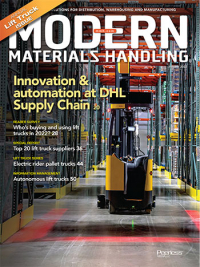60 Seconds with… Maya Xiao, Senior Analyst at Interact Analysis
Our editor sat down with Maya Xiao to discuss the current and future lift truck industry.

Title: Senior Analyst
Location: Shanghai, China
Experience: Five years as an analyst at Interact Analysis, where she covers the lift truck industry and automation, including industrial robots.
Modern: Maya, how has the lift truck industry performed over the last year?
Xiao: I started tracking the lift truck market in 2018, and my first report was in 2020. Since then, the market has been growing fast, especially in the Class 2 and Class 3 segments.
Modern: What do you think is driving the industry today?
Xiao: Although I divide the market into manufacturing and distribution, if you look at it in general, it’s the growth of e-commerce, labor shortages and the increasing cost of labor. And in the market for electric trucks, it’s the need for zero emissions indoor and even outdoors at the ports.
Modern: Lift trucks are a mature technology, but are there technological changes you’re following?
Xiao: There are two: The first is the electrification of vehicles and the second is autonomy. There is the replacement of ICE batteries with lithium and hydrogen fuel cells. Battery prices will continue to decrease, but more importantly are environmental policies coming out of Europe and the APAC regions. As to autonomy, forklifts are one link in warehouse automation. In North America, we’re already seeing some fully automated, connected warehouses, and in APAC, it’s coming.
Modern: Lift trucks are entering the automation space. What’s the state of that technology?
Xiao: It’s still in the emerging or trial stage, where a typical project is just five or 10 vehicles. Right now, you can’t just copy and paste autonomous lift trucks into your warehouse. But, it’s maturing, and I think 2025 will be a turning point as more of the early pioneers gain experience.
Modern: Do you think the trajectory of growth for autonomous lift trucks will be like what we saw with AMRs? In that market, DHL began a few years ago with fewer than 10 in one facility and today have deployed more than 2,000 worldwide.
Xiao: ALTs are different from AMRs. The average price of an autonomous lift truck is about 10 times that of an AMR. That’s a big gap. What’s more, other competing technologies might come along. That’s why I think we’ll get a signal by 2025.
Modern: What excites you most about what’s next for the industry?
Xiao: When I started my research, lift trucks had a function in manufacturing and warehousing, but they were not integrated into a whole system like an AMR. In the future, however, I think the small lift trucks, like Class 3, will be able to do that. It’s a mature market, with hundreds of thousands of units in the field, but it’s still growing fast because of those trends I mentioned at the outset.

Article Topics
Interact Analysis News & Resources
Forklift market to be 50% bigger by 2032, Interact Analysis forecasts Interact Analysis: warehouse automation market to return to growth in 2024 Chinese warehouse automation market set to grow at CAGR of 13.5% over next 5 years Interact Analysis: warehouse construction declines by 25% in 2023 ‘Steady’ growth of 5-7% forecast for global industrial robot market Robotic picking market worth $6.8 billion by 2030, up from $236 million last year Interact Analysis: logistics and other new application scenarios key to cobot market success More Interact AnalysisLatest in Materials Handling
AutoStore to launch U.S. headquarters in greater Boston region Trew expanding manufacturing and development campus in southwest Ohio IFR: robot installations by U.S. manufacturing companies up 12 percent last year Geek+ and System Teknik deploy PopPick solution for pharmacy group Med24.dk Beckhoff USA opens new office in Austin, Texas Manhattan Associates selects TeamViewer as partner for warehouse vision picking ASME Foundation wins grant for technical workforce development More Materials HandlingSubscribe to Materials Handling Magazine

Find out what the world's most innovative companies are doing to improve productivity in their plants and distribution centers.
Start your FREE subscription today.
April 2024 Modern Materials Handling

Latest Resources











